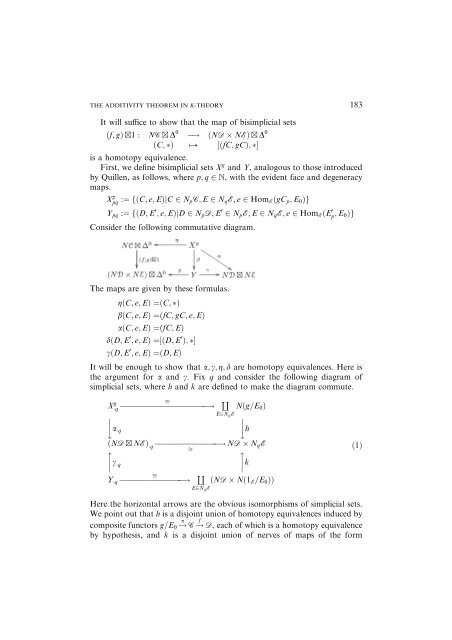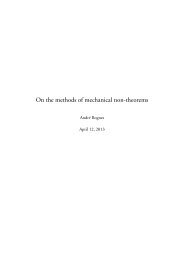The Additivity Theorem in K
The Additivity Theorem in K
The Additivity Theorem in K
You also want an ePaper? Increase the reach of your titles
YUMPU automatically turns print PDFs into web optimized ePapers that Google loves.
THE ADDITIVITY THEOREM IN K-THEORY 183<br />
It will suffice to show that the map of bisimplicial sets<br />
ðf; gÞ 1 : NC D 0 ! ð ND NEÞ D 0<br />
ðC; Þ # ½ðfC; gCÞ; Š<br />
is a homotopy equivalence.<br />
First, we def<strong>in</strong>e bisimplicial sets Xg and Y, analogous to those <strong>in</strong>troduced<br />
by Quillen, as follows, where p; q 2 N, with the evident face and degeneracy<br />
maps.<br />
X g pq :¼fðC; e; EÞjC 2 NpC; E 2 NqE; e 2 HomEðgCp; E0Þg<br />
Ypq :¼ fðD; E 0 ; e; EÞjD 2 NpD; E 0 2 NpE; E 2 NqE; e 2 HomEðE 0 p ; E0Þg<br />
Consider the follow<strong>in</strong>g commutative diagram.<br />
<strong>The</strong> maps are given by these formulas.<br />
gðC; e; EÞ ¼ðC; Þ<br />
bðC; e; EÞ ¼ðfC; gC; e; EÞ<br />
aðC; e; EÞ ¼ðfC; EÞ<br />
dðD; E 0 ; e; EÞ ¼½ðD; E 0 Þ; Š<br />
cðD; E 0 ; e; EÞ ¼ðD; EÞ<br />
It will be enough to show that a; c; g; d are homotopy equivalences. Here is<br />
the argument for a and c. Fix q and consider the follow<strong>in</strong>g diagram of<br />
simplicial sets, where h and k are def<strong>in</strong>ed to make the diagram commute.<br />
Xg q ƒƒƒƒƒƒƒƒƒƒƒƒƒƒƒƒƒƒƒ!<br />
ffi<br />
‘<br />
Nðg=E0Þ<br />
E2NqE<br />
?<br />
ya ?<br />
q<br />
yh ðND<br />
x<br />
?<br />
NEÞ q ƒƒƒƒƒƒƒƒƒƒƒƒƒƒ! ND NqE<br />
ffi<br />
c q<br />
x<br />
? k<br />
‘<br />
ðND Nð1E=E0ÞÞ<br />
ffi<br />
Y q ƒƒƒƒƒƒƒƒƒƒƒƒƒƒ!<br />
E2NqE<br />
Here the horizontal arrows are the obvious isomorphisms of simplicial sets.<br />
We po<strong>in</strong>t out that h is a disjo<strong>in</strong>t union of homotopy equivalences <strong>in</strong>duced by<br />
composite functors g=E0 ! p C ! f D, each of which is a homotopy equivalence<br />
by hypothesis, and k is a disjo<strong>in</strong>t union of nerves of maps of the form<br />
ð1Þ

















